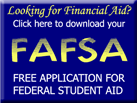
 |
|
|

|
Content provided by the Catalog of Federal Domestic Assistance
84.120 Minority Science and Engineering Improvement FEDERAL AGENCY: OFFICE OF ASSISTANT SECRETARY FOR POSTSECONDARY EDUCATION, DEPARTMENT OF EDUCATION AUTHORIZATION: Higher Education Act of 1965, Title III, Part E, Subpart 1, as amended.
To (1) Effect long-range improvement in science and engineering education at predominantly minority institutions and (2) increase the participation of underrepresented ethnic minorities, particularly minority women, in scientific and technological careers. TYPES OF ASSISTANCE:
USES AND USE RESTRICTIONS: Grant funds may be used for paying costs necessary for improving and maintaining high quality science and engineering education programs in minority postsecondary institutions, including salaries and wages, equipment and instructional materials and supplies, travel related to the project activities, faculty development, and other direct and indirect costs. This program is subject to non- supplanting requiements and must use a restricted indirect cost rate which is referenced under 34 CFR 76.564-76.569. For assistance call the Office of the Chief Financial Officer/Indirect Cost Group on 202-708-7770. ELIGIBILITY
REQUIREMENTS: Applicant Eligibility: Private and public nonprofit accredited institutions of higher education that award baccalaureate degrees; and are minority institutions, public or private nonprofit institutions of higher education that award associate degrees, and are minority institutions that have a curriculum that includes science or engineering subjects; and enters into a partnership with public or private nonprofit institutions of higher education that award baccalaureate degrees in science or engineering. Applications may also be submitted by nonprofit science-oriented organizations, professional scientific societies, and institutions of higher education that award baccalaureate degrees, that provide a needed service to a group of minority institutions; or provide in-service training for project directors, scientists, and engineers from minority institutions; or consortia of organizations, that provide needed services to one or more minority institutions, the membership of which may include: institutions of higher education which have a curriculum in science and engineering; institutions of higher education that have graduate or professional programs in science or engineering; research laboratories of, or under contract with the Department of Energy; private organizations that have science and engineering facilities; or quasi-governmental entities that have a significant scientific or engineering mission.
Pre-application Coordination: The standard application forms as furnished by the Federal agency and required by OMB Circular No. A-102 must be used for this program. This program is eligible for coverage under E.O. 12372, "Intergovernmental Review of Federal Programs." An applicant should consult the office or official designated as the single point of contact in his or her State for more information on the process the State requires to be followed in applying for assistance, if the State has selected the program for review. ASSISTANCE CONSIDERATIONS: Formula and Matching Requirements: The program suggests that some institutional contribution be included as part of program support. However, by law, this program has no matching requirements. POST ASSISTANCE REQUIREMENTS: Reports: The program requires interim performance reports from directors of projects having duration of more than one year at the end of each budget year's activities. A substantive performance and financial report is required within 90 days upon completion of the project for all funded projects. FINANCIAL INFORMATION: Account Identification: 91-0201-0-1-502.
In fiscal year 2001, 101 awards were made. REGULATIONS, GUIDELINES, AND LITERATURE: 34 Code of Federal Regulations. INFORMATION CONTACTS: Regional or Local Office: Not applicable. EXAMPLES OF FUNDED PROJECTS: (1) A project is providing state-of- the-art training to minority students in field and laboratory studies dealing with water quality, and educating students on the benefits of using an interdisciplinary approach to solving environmental problems. (2) A project has a summer science program designed to improve access of pre-college (8th and 9th grade) minority students to careers in science and engineering. Integrated, hands-on curriculum in biology, physical science, mathematics, and computer technology is offered. (3) A project is a consortium of five minority serving community colleges across the nation and two engineering schools whose purpose is to share resources and strategies in order to increase the number of bilingual engineers and strengthen the educational pipeline from pre-college through engineering school. (4) One project is to establish a computer laboratory in science and mathematics. CRITERIA FOR SELECTING PROPOSALS: Decisions are based primarily on the scientific and educational merits of described activities and conformance with the objectives of the program. Priority is given to applicants which have not previously received funding from the Minority Science Improvement Program and to previous grantees with a proven record of success, as well as to proposals that contribute to achieving balance among projects with respect to geographic region, academic discipline and project type.
|
| ||
|
State Money
|
Federal Money
|
Private Money
|
Low Cost Colleges
|

|